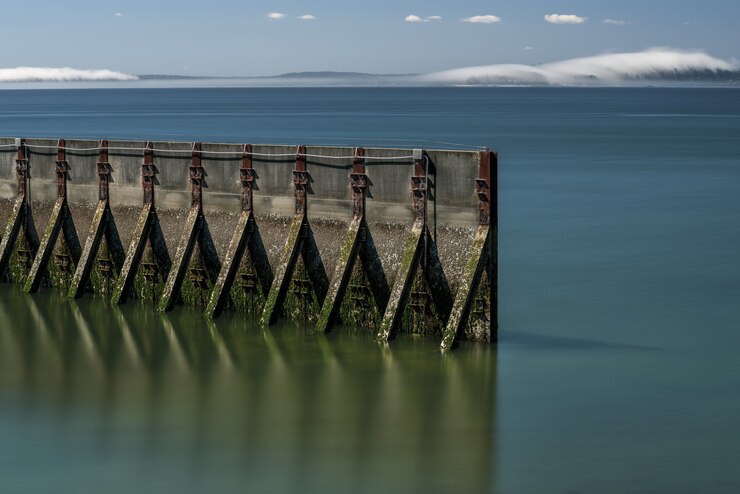Seawalls are essential in shielding properties from damaging waves and erosion. They serve as barriers protecting homes and amenities from the relentless forces of water. Over time, however, these structures can deteriorate, leading to potential property and environmental damage. As a homeowner, understanding the signs of seawall decay can save you from future headaches and expenses.
If you’ve noticed signs of wear and tear on your seawall, you’re not alone. Recognizing the early indications and taking prompt action is crucial in maintaining the safety and longevity of your waterfront property. Let’s explore some signs that your seawall may be crumbling and what immediate steps you can take.
Signs Your Seawall is Crumbling
Being alert to the condition of your seawall is like keeping an eye on a well-worn road after a harsh winter. You can spot potential issues before they escalate.
- Cracks and Gaps: Inspecting your seawall for visible cracks and gaps is essential. These can indicate weakening structural integrity that might worsen during storms or high tides.
- Visible Rust: Pay close attention to metal components. Rust can be an early sign of corrosion, compromising the stability of the entire structure.
- Soil Erosion: Check for soil erosion around the base. This can signify that water is seeping through weakened areas, eroding the foundational support.
- Leaning or Bowing Sections: If sections of your seawall are leaning or bowing, it could indicate serious foundational issues, requiring immediate attention.
Recognizing these signs early not only helps in maintaining safety but also provides an opportunity to address minor issues before they escalate into costly repairs.
Immediate Actions to Take
Once you’ve identified potential issues, taking immediate action can prevent further damage. Here’s what you can do right away:
1. Inspect Thoroughly: Give the seawall a detailed inspection. Look for any obvious problems, such as large gaps or displaced stones.
2. Document Damage: Take photos of any visible damage. This documentation can be helpful if you need to consult with a repair specialist.
3. Temporary Supports: If you notice any leaning areas, consider adding temporary supports. Be cautious and ensure the support is safe and effective.
4. Avoid Heavy Loads: Minimize any heavy loads or activities near the seawall that could exacerbate current issues. This includes refraining from adding extra weight or conducting heavy construction nearby.
Taking these steps promptly will help manage and possibly mitigate damage while you seek professional assistance. Remember, the goal is to stabilize the situation as much as possible until help arrives.
Professional Repair Options
After assessing the condition of your seawall and taking immediate steps, it’s time to consider long-term solutions. Professional repair services bring expertise and the right tools to effectively address these problems. When a seawall shows evident signs of crumbling, checking in with a skilled professional can save both time and money in the long run.
First, a comprehensive assessment will be conducted to determine the extent of the damage. This assessment involves examining the structural integrity and identifying the problem areas that need urgent attention. Using their findings, professionals can employ various repair methods – one common technique is sealing cracks to prevent further water infiltration. Reinforcing weak sections with new materials can also help in bolstering the seawall’s strength.
Sometimes, additional support structures may be necessary. These could involve anchoring systems or barriers that provide extra stability. Hiring experts ensures that repairs are done correctly and efficiently, helping to secure your property against future erosion challenges.
Preventative Measures for Future Maintenance
To keep your seawall in top shape after repairs, adopting preventative measures is key. Regular inspections help catch small problems before they grow into significant issues. By checking your seawall periodically, you ensure its resilience against the elements.
Installing proper drainage systems is another essential step in maintaining your seawall. Good drainage helps to manage water flow and reduce pressure on the structure. Alongside drainage, using protective coatings can combat rust and other forms of degradation, prolonging the life of metal components.
Routine maintenance doesn’t have to be overwhelming. Simple actions like removing debris that accumulates against the seawall or checking for new signs of wear can make a big difference. Following a consistent maintenance plan will help you keep your seawall strong and reliable over the years.
Ensuring the Longevity of Your Seawall
Keeping your seawall in great condition benefits not only the seawall itself but also your entire property. Timely inspections and necessary professional repairs play a critical role in warding off significant issues. By addressing problems early, you keep repair costs down and ensure your seawall can continue to protect your home effectively.
Think of preventative measures as a small investment in peace of mind. By taking the time to implement simple upkeep habits, you’re setting the stage for long-term satisfaction and safety. As you safeguard your seawall, you’re safeguarding your home’s future.
By prioritizing these steps, you not only maintain an essential barrier against the forces of nature but also contribute to the lasting beauty and security of your waterfront property. Whether through proactive repairs or regular maintenance, every effort counts in ensuring your seawall remains a dependable asset for years to come.
For reliable and professional help in maintaining the strength and security of your seawall, look no further than Lift-Texas Construction. Learn how we can assist you to expertly repair the seawall and ensure your property remains protected against the elements. Visit our dedicated page at Repair the Seawall to find out how we can help you safeguard your investment today.

